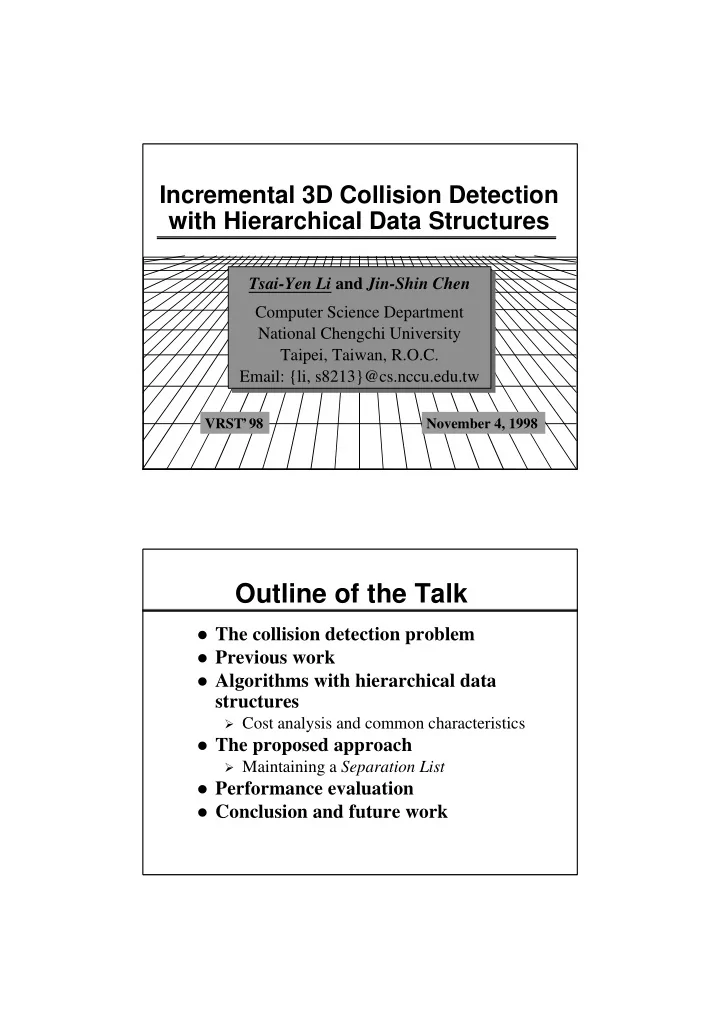

Incremental 3D Collision Detection with Hierarchical Data Structures Tsai-Yen Li and Jin-Shin Chen Computer Science Department National Chengchi University Taipei, Taiwan, R.O.C. Email: {li, s8213}@cs.nccu.edu.tw VRST’98 November 4, 1998 Outline of the Talk � The collision detection problem � Previous work � Algorithms with hierarchical data structures � Cost analysis and common characteristics � The proposed approach � Maintaining a Separation List � Performance evaluation � Conclusion and future work
The Considered Problem: 3D Collision Detection � Determine interference between objects � Special case of distance determination � Applications: � VR and 3D Graphics � Robotics � CAD/CAM (e.g. Maintainability Study) � Key components of: � 3D Interactive Graphics (VR) � Dynamic Simulation � Motion Planning Previous Work � Tracking Closest Features between Polyhedra � Gilbert (1988) and Cameron (1997): O ( n ) and O (1) � Lin (1993): O (1) � common problem: convexity requirement � Bounding Volumes (BV) for Polygonal Facets � Sphere Trees: Hubbard (1993), Quinlan (1994) � OBB Trees: Gottschalk, et al. (1996) � DOP Trees: Klosowski(1996), Zachmann (1998) � Spherical-Shell Trees: Krishnan, et al. (1998) � etc.
Hierarchical Bounding Volumes : An Example � Sphere-tree built from bottom up Primitives Root of a BV tree Basic Recursive Algorithm Boolean CheckBVCollision (node N1 , node N2 ) if both N1 an N2 are leaves then return CheckPrimitiveCollision( N1 , N2 ) elseif N2 is larger than N1 then for each child N2 [ i ] of N2 if CheckBVCollision( N1 , N2 [ i ]) then return TRUE else for each child N1 [ i ] of N1 if CheckBVCollision( N1 [ i ], N2 ) then return TRUE return FALSE
Cost Analysis of Algorithms with Hierarchical Data Structures = × + × + × T N C N C N C u u v v p p � T : total cost for an interference check � N u :no. of BV’s updated � C u :cost of updating a BV � N v : no. of BV overlap tests � C v : cost of testing two BV’s for overlaps � N p :no. of primitive pairs tested for interference � C p :cost of testing two primitives for interference Typical Recursion Tree and Separation List Bounding Volume Tree Recursion Tree A BVTree 1 A, a B C Obj 1 B, a C, a D E F G B, b B, c C, b C, c B, b C, c + = F, c G, c D, b E, b D, c E, c F, b G, b D, c F, b G, b a BVTree 2 …………… E, f E, g E, f E, g c b Obj 2 Separation list: (B,b), (D,c), e g d f (E,f), (E, g), (F, b), (G, b), (C, c)
Number of Nodes in a Recursion Tree # nodes/level # nodes above 1 0 2 1 4 3 ... . . . . . . ... ... n/2 n/2 - 1 ... ... ... n n - 1 Case 1 (still): Case 2 (down): Case 3 (up): 2n - 1 1 / 2 n = 1 / 2 n n - 1 3 / 4 n = - 3 / 4 n 2n - n = n Predicting Motions of a Separation List � Update Strategy: � Do not shrink the list. Rebuild the separation list when objects are predicted to be moving apart. � Prediction Strategy: � Getting Closer: when size of the list grows. � Getting Farther: when the list stops growing. Farther or closer Predict Closer Predict n-1 Closer Farther Farther n Case 1 (still): Case 2 (down): Case 3 (up): 2n - n = n 2n - n = n n - n = 0
Deferring Rebuilding a Separation List � Modified Prediction Strategy: � Deferring rebuilding the separation list by one run. � Possible situations of no growth after two runs: Father or (up, up), Closer closer Predict Predict (up, still), Close Farther (up, down), (still, up), Farther Closer Farther (still, still) Predict Close Implementation and Experiment � Implemented a sphere-tree algorithm (Quinlan, 1994), part of a path planner. � Written in C++. � Runs on most UNIX machines. � Data taken on a PC (K5, 133MHz) running Linux 2.0.7. � Experiments: � Nine bunnies with 500 polygons each moving randomly in a closed workspace. � Increments: 5 degrees for rotation and radius of the smallest sphere for translation.
Performance Evaluation Original Using SL Deferred SL time time time Run # (sec.) (sec.) speedup (sec.) speedup 1 1507.9 1075.7 40% 759.2 99% 2 1744 1252.2 39% 1021.7 71% 3 1552.8 1077.7 44% 781.5 99% 4 1713 1177.3 46% 980.1 75% 5 1548.4 1080.5 43% 808.2 92% 6 1653.4 1168.3 42% 969.5 71% 7 1403 1021.2 37% 687.5 104% 8 1570.5 1120.2 40% 831.4 89% 9 1564.9 1163.1 35% 900.4 74% 10 1580.5 1139.2 39% 865.7 83% Ave. 1583.8 1127.5 40% 860.5 84% Conclusion � Efficient collision detection algorithms are crucial for 3D/VR applications. � Improved efficiency of a class of algorithms with hierarchical data structures. � Captured spatial and temporal coherence by using a separation list. � Proposed strategies for maintaining a separation list.
Future Work � Needing more experiments on different geometry complexity and settings. � Experimenting on more hierarchical data structures such as OBB trees (preliminary results). � Obtaining quantitative relation between spatial coherence and performance improvement. � Incorporating the collision detection module into a VRML browser. Q & A
Recommend
More recommend